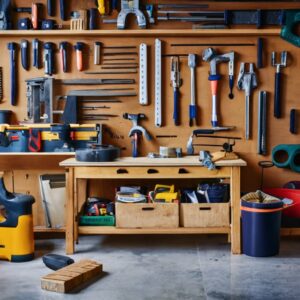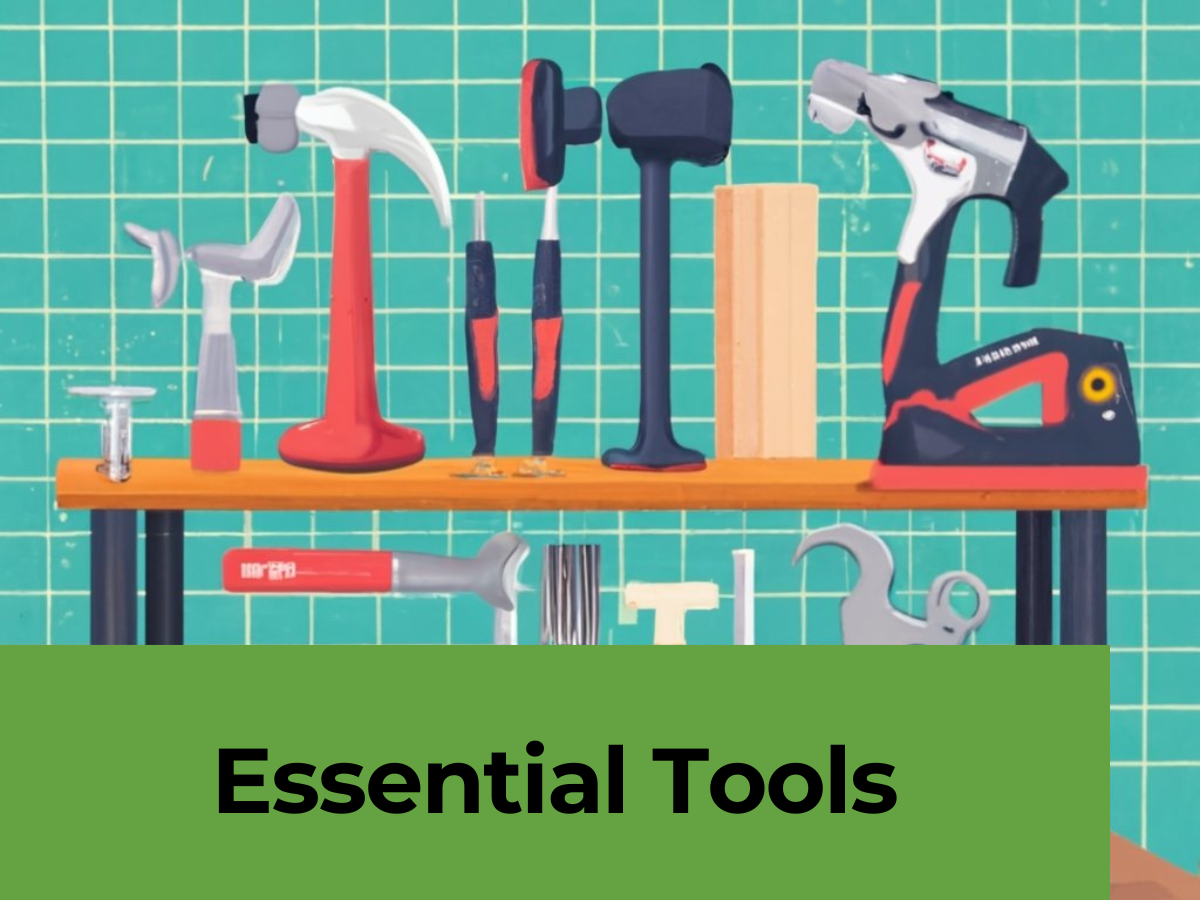Imagine stepping into the world of DIY and woodworking, where you have the power to create and transform. But before you embark on your journey, you need to equip yourself with the essential tools.
From saws that slice through wood like a hot knife through butter, to drills that effortlessly fasten pieces together. In this article, we will guide you through the must-have tools that will turn your DIY dreams into reality.
Key Takeaways
- Regular cleaning, oiling, and sharpening prolong tool lifespan
- Proper tool safety is paramount
- Using the right tool for the job makes work easier and more efficient
- Proper tool storage prevents damage and keeps tools organized
Tool Types
To complete basic DIY and woodworking projects, you’ll need a variety of tools. Tool maintenance is crucial to ensure that your tools remain in good working condition. Regular cleaning, oiling, and sharpening will help prolong their lifespan.
When it comes to project planning, it’s important to consider the tools you’ll need and make sure you have them on hand before starting. Proper tool safety is paramount, so always follow manufacturer instructions, wear appropriate protective gear, and use tools in a well-lit and ventilated area.
Tool selection is important too, as using the right tool for the job will make your work easier and more efficient. Lastly, proper tool storage is essential to prevent damage and keep your tools organized.
Now, let’s move on to discussing the importance of safety equipment.
Safety Equipment
For basic DIY and woodworking projects, you will need safety equipment. Ensuring your safety is paramount when working with tools and materials. Here are some essential safety equipment and their significance in protecting you during your projects:
| Safety Equipment | Importance |
|---|---|
| Safety Goggles | Protects your eyes from flying debris, sparks, and harmful chemicals in DIY projects. |
| Respirator | Choosing the right respirator is crucial to safeguard your lungs from dust, fumes, and harmful particles during woodworking. |
| Gloves | Different types of gloves such as leather, latex, or rubber provide protection against cuts, splinters, and chemical exposure in woodworking. |
Furthermore, hearing protection is essential in DIY projects, as prolonged exposure to loud noises can damage your hearing. Lastly, when working with power tools, make sure to wear a hard hat, steel-toed boots, and a dust mask to protect yourself from potential hazards. Remember, your safety should always be a top priority in any DIY or woodworking project.
Measurement Tools
Measure accurately and confidently with essential tools like a tape measure, ruler, and combination square. When it comes to measuring accuracy, having the right tools is crucial.
A tape measure is a versatile tool that allows you to measure length, width, and height with ease. Choose a tape measure with clear markings and a sturdy construction for durability. For more precise measurements, digital measuring tools are a great option. These tools provide accurate readings and often have additional features like memory functions and the ability to switch between units of measurement.
When measuring angles, a combination square is essential. It allows you to measure and mark angles accurately, ensuring your cuts and joints are precise. Additionally, for measuring irregular shapes, a flexible measuring tape or contour gauge can be incredibly useful.
With the right measurement tools, you can ensure your DIY and woodworking projects are done with precision and accuracy.
Now, let’s move on to the next section about drilling and fastening.
Drilling & Fastening
Now, let’s move on to drilling and fastening, essential steps in your DIY and woodworking projects. Here are some key points to consider:
- Types of drill bits: There are various types of drill bits available, such as twist, spade, and Forstner bits. Each serves a different purpose, so it’s important to choose the right one for your project.
- Choosing the right screws: Selecting the appropriate screws is crucial for ensuring strong and secure joints. Consider factors such as the type of material you’re working with and the weight-bearing capacity required.
- Best practices for drilling into different materials: Different materials require different drilling techniques. For example, drilling into wood requires a slower speed, while drilling into metal requires a higher speed.
- Common drilling mistakes to avoid: Avoid common mistakes like applying excessive pressure, using the wrong drill bit, or drilling at the wrong angle. These can lead to damaged materials or ineffective results.
- How to properly use a drill driver: Familiarize yourself with the functions and settings of your drill driver. Ensure the chuck is properly tightened and use the appropriate speed and torque settings for your project.
Cutting Tools
As you continue exploring essential tools in basic DIY and woodworking projects, one key aspect to consider is the use of cutting tools. Cutting techniques play a crucial role in achieving accurate and precise cuts, whether you’re working with wood, metal, or other materials.
To ensure cutting accuracy, it’s important to maintain your cutting tools properly. Regular blade maintenance, such as sharpening and cleaning, will help keep the blades in optimal condition for smooth cutting. Additionally, selecting the right blade for the job is essential. Different blades are designed for specific materials and cutting tasks, so choosing the appropriate one will enhance both efficiency and safety.
Remember to prioritize cutting safety by following proper procedures, wearing protective gear, and using cutting tools as intended.
Sanding & Finishing
To achieve a smooth and polished end result, sanding and finishing are crucial steps in the DIY and woodworking process. Proper sanding techniques prepare the surface for staining or varnish application, ensuring a flawless finish. Here are some essential tools and methods for sanding and finishing:
- Sandpaper: Use various grits of sandpaper to gradually smooth the wood surface, starting with a coarse grit and progressing to a finer grit.
- Sanding block: A sanding block provides stability and even pressure during sanding, resulting in a more uniform finish.
- Wood stain: Apply wood stain to enhance the natural beauty of the wood and add depth and color.
- Varnish: Varnish provides a protective layer and a glossy finish to the wood, enhancing its durability and appearance.
- Polishing methods: Use polishing compounds or a buffing wheel to achieve a high-gloss finish and remove any remaining imperfections.
Joining & Clamping

To achieve secure and sturdy connections in your DIY and woodworking projects, you will need a variety of essential tools for joining and clamping. When it comes to joining materials together, choosing the right type of glue is crucial. Consider factors such as the materials being joined, the strength required, and the drying time. Some common types of glue include wood glue, epoxy, and polyurethane glue.
In addition to glue, using the appropriate clamps is essential for holding pieces together while the glue sets. There are various types of clamps available, such as bar clamps, pipe clamps, and spring clamps. Each has its own advantages and applications.
Proper joinery techniques, like mortise and tenon joints or dovetail joints, are crucial for creating strong connections. It’s important to practice these techniques and ensure precise measurements and cuts.
When it comes to clamping, using the right technique is essential. Apply even pressure across the joint, making sure the pieces are aligned properly. Avoid over-tightening the clamps, as it can lead to warping or damage to the materials.
Common joining mistakes include using insufficient glue, not applying enough clamping pressure, or rushing the drying time. Take your time and follow the instructions carefully to achieve the best results.
In the next section, we will discuss the importance of storage and organization in your DIY and woodworking projects.
| Glue Selection | Types of Clamps | Joinery Techniques |
|---|---|---|
| Wood Glue | Bar Clamps | Mortise and Tenon |
| Epoxy | Pipe Clamps | Dovetail |
| Polyurethane | Spring Clamps | Butt Joint |
Transition: Now that you have learned about the essential tools and techniques for joining and clamping, let’s move on to the importance of storage and organization in your DIY and woodworking projects.
Storage & Organization
Now let’s delve into the importance of storage and organization in your DIY and woodworking projects, ensuring that all your tools and materials are easily accessible and well-maintained.
Here are some creative solutions, space-saving ideas, and organization tips to help you keep your workspace tidy and efficient:
- Utilize wall space by installing pegboards or tool racks to hang your frequently used tools.
- Repurpose items such as jars, cans, or old cabinets to create storage containers for small items like screws, nails, and bolts.
- Make use of vertical space by installing shelves or cabinets to store larger tools and equipment.
- Implement DIY storage hacks such as magnetic strips for holding metal tools or PVC pipe organizers for storing long items like pipes or dowels.
- Label and categorize your storage containers to easily locate items when needed.
By implementing these storage and organization strategies, you can create a clutter-free workspace that allows for easy access to your tools and materials.
Now let’s move on to the next section, where we’ll discuss the essential hand tools for your DIY and woodworking projects.
Hand Tools
Once you have organized your workspace, it’s time to focus on the essential hand tools you’ll need for your DIY and woodworking projects.
Hand tool maintenance is crucial to ensure their longevity and optimal performance.
When selecting hand tools, consider their durability, ergonomics, and suitability for the task at hand.
Prioritize tool safety by using appropriate personal protective equipment and following proper techniques.
After each use, store your hand tools in a designated place to prevent damage and ensure easy accessibility.
Regular tool maintenance, such as cleaning and lubricating, will keep them in top condition.
With these essential hand tools and proper care, you’ll be ready to tackle your DIY and woodworking projects with confidence.
Now, let’s move on to discussing the indispensable power tools you’ll need.
Power Tools

When working on basic DIY and woodworking projects, you’ll need a variety of power tools to assist you. These tools can help you cut, shape, drill, and fasten materials with ease. Here are some essential power tools to consider:
- Circular Saw: Perfect for cutting straight lines in wood and other materials.
- Cordless Drill: Ideal for drilling holes and driving screws without the hassle of cords.
- Random Orbital Sander: Great for smoothing surfaces and removing rough edges.
- Jigsaw: Allows for intricate cuts and curves in various materials.
- Router: Essential for creating decorative edges and hollowing out spaces.
To ensure the longevity of your power tools, regular maintenance is crucial. Clean them after each use, lubricate moving parts, and store them properly. Additionally, invest in power tool accessories such as extra batteries and different blades to expand their capabilities.
When selecting power tools, consider factors like brand reputation, warranty, and reviews. Lastly, prioritize safety by wearing protective gear, following instructions, and keeping a clean workspace. Popular power tool brands include DeWalt, Makita, Bosch, Milwaukee, and Ryobi.
Frequently Asked Questions
How Much Does a Basic DIY Tool Set Typically Cost?
You’ll be pleased to know that a basic DIY tool set typically doesn’t break the bank. Cost estimation depends on your budget, but keep in mind that quality vs price is important. Beginner-friendly options and different tool set options are available.
Are There Any Specific Safety Precautions That Should Be Taken When Using Power Tools?
When using power tools, it is crucial to take safety precautions. Proper tool handling, wearing protective equipment, and getting training are essential. Common power tool injuries can be avoided with these measures.
What Are Some Common Mistakes to Avoid When Measuring and Using Measurement Tools?
To avoid common measuring mistakes and ensure precision in woodworking, follow these tips: use a tape measure with clear markings, double-check measurements, avoid parallax errors, and practice proper measuring techniques for accuracy.
Can Drilling and Fastening Tools Be Used Interchangeably for Different Materials?
When considering the interchangeability of drilling and fastening tools for different materials, it’s important to choose the right drill bits and use proper fastening techniques. Power tools offer advantages in efficiency and precision.
Is It Necessary to Have Both Hand Tools and Power Tools, or Can One Be Used in Place of the Other for Basic Woodworking Projects?
You can use hand tools or power tools for basic woodworking projects, but both have their advantages. Hand tools offer precision and control, while power tools provide speed and efficiency. A combination of both can give you optimal results.
Conclusion
In conclusion, having the right tools for DIY and woodworking projects is essential for success.
From safety equipment to measurement tools, drilling and cutting tools, joining and clamping devices, and storage and organization solutions, each tool serves a specific purpose.
Remember, ‘measure twice, cut once’ to avoid costly mistakes.
So, equip yourself with these essential tools and get ready to tackle your next project with confidence and precision.
Happy DIY-ing!

I’m James Brown, the founder and editor of DIYINUSE.COM. I have over 15 years of hands-on woodworking and DIY experience that I share through tips and project inspiration on my website. When I’m not working on home improvement projects or creating content for the site, I enjoy spending time outdoors hiking and fishing. I’m always looking to expand my creativity and DIY skills by learning new techniques.
